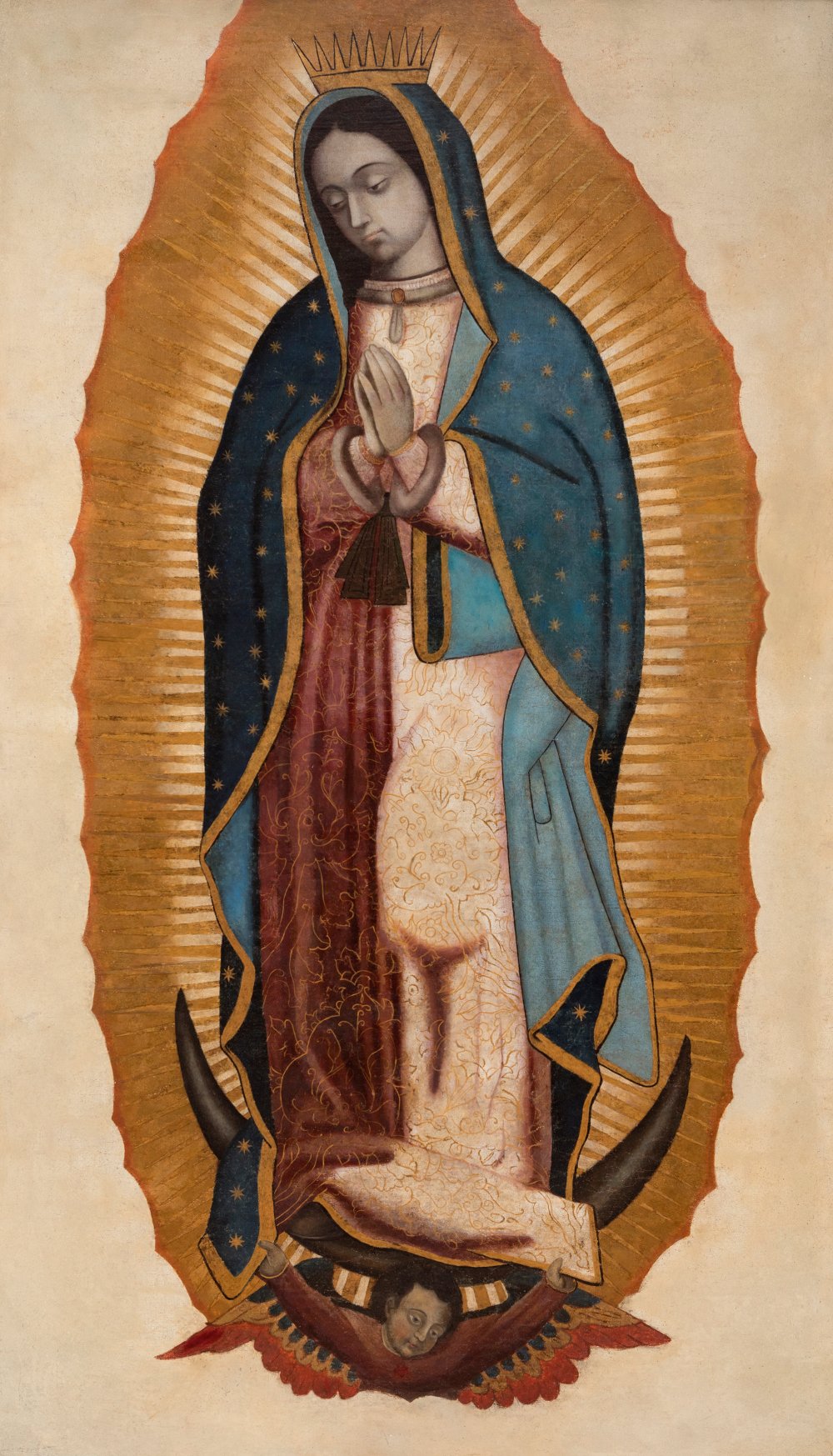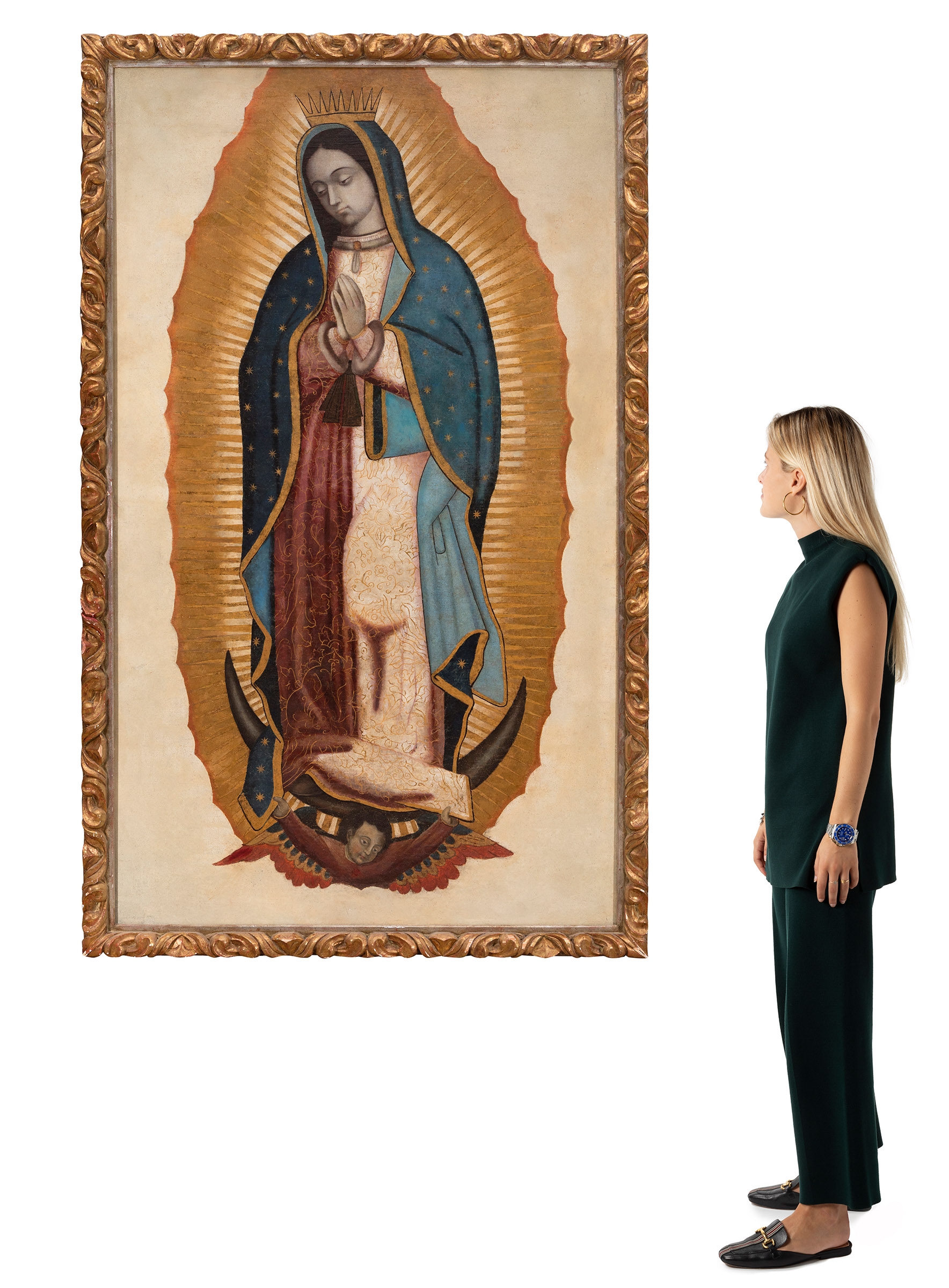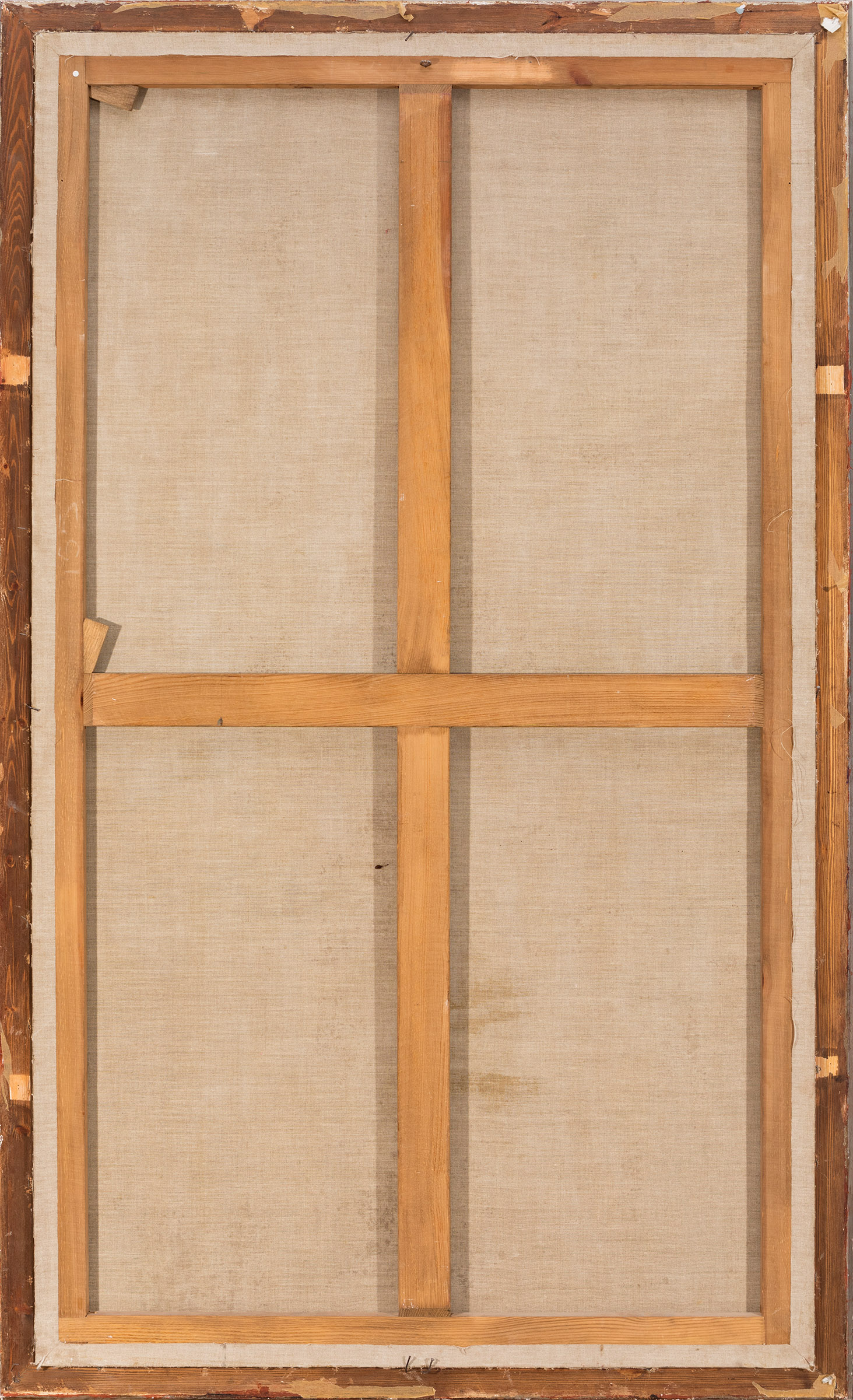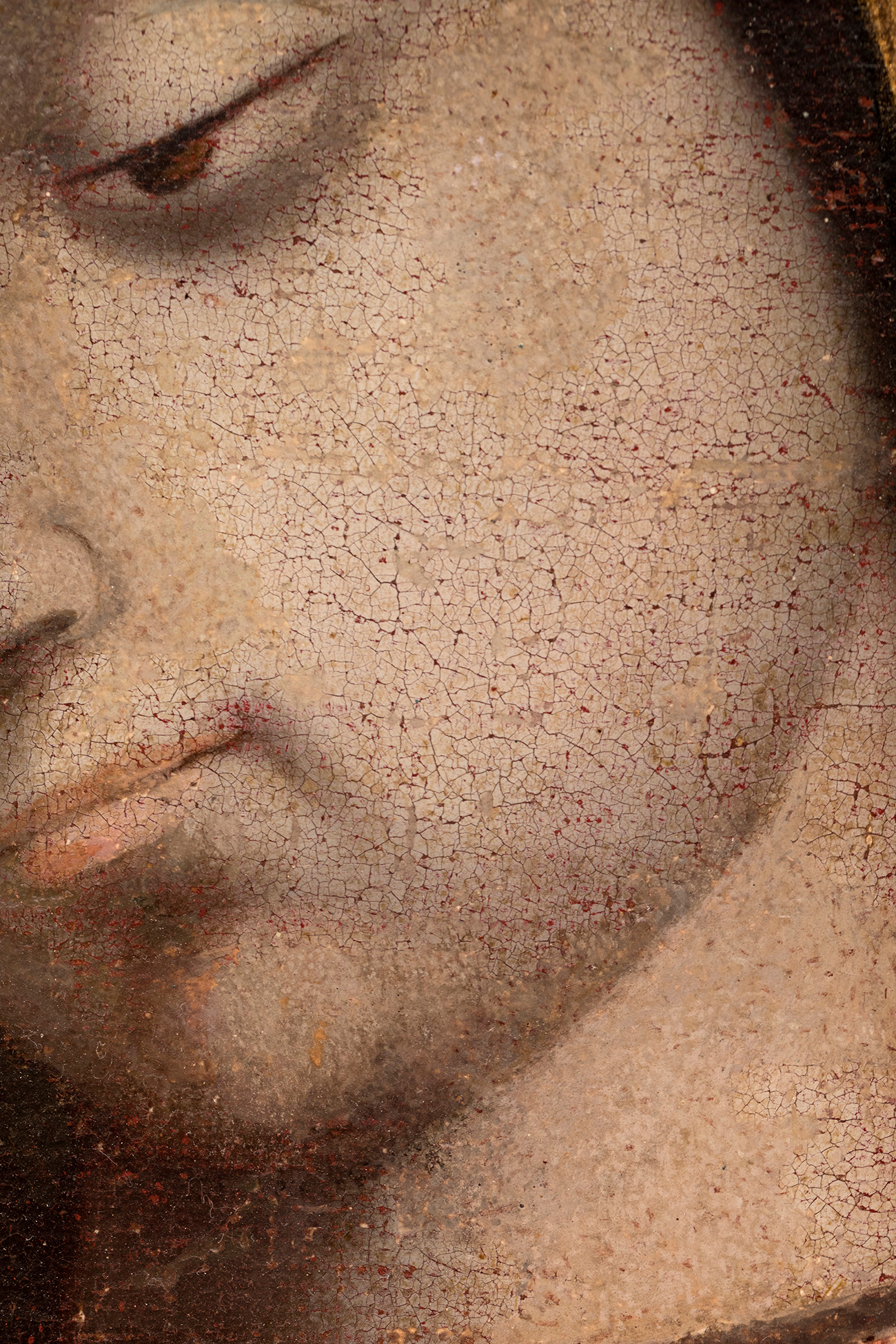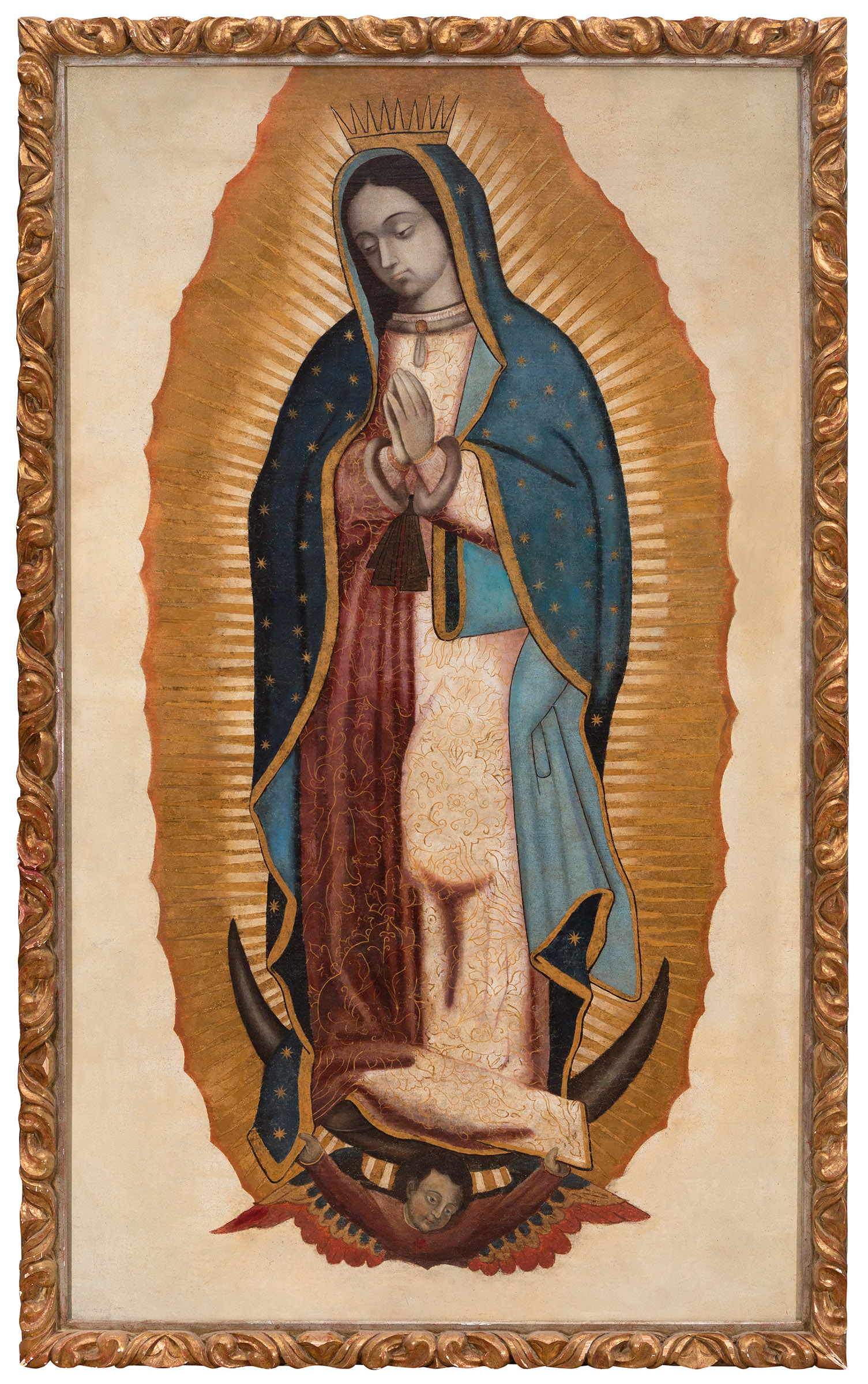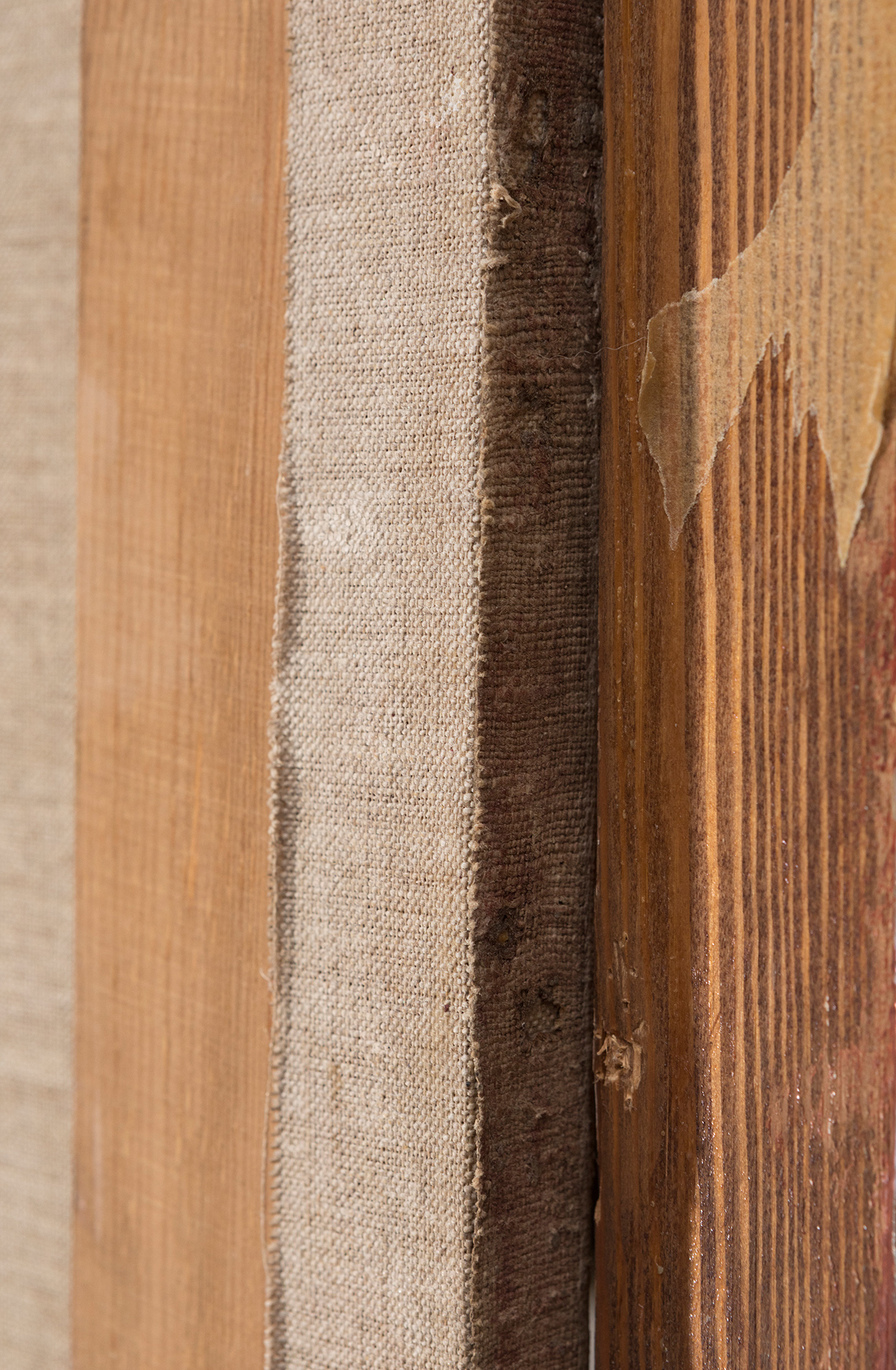58
Mexican school of the 18th century."Virgin of Guadalupe".Oil on canvas.Size: 178 x 104 cm; 189 x 115
1/6
Description
Mexican school of the 18th century.
"Virgin of Guadalupe".
Oil on canvas.
Size: 178 x 104 cm; 189 x 115 cm (frame).
The iconography of the Virgin of Guadalupe acquired great richness and variety especially from the 17th century onwards. The representation we are dealing with here faithfully follows that of the original canvas (attributed to the native Marcos Cípac, 16th century): the crescent moon at her feet held by an angel, the rays bordering the figure, the mandorla, the crown, the dark complexion of the Virgin? Our Lady of Guadalupe is a Marian invocation of the Catholic Church, whose image has its main centre of worship in the Basilica of Guadalupe, in the north of Mexico City. According to Mexican oral tradition, it is believed that the Virgin Mary appeared four times to Saint Juan Diego Cuauhtlatoatzin on the hill of Tepeyac. Juan Diego, in the last apparition of the Virgin, carried in his ayate some flowers that he had cut on Tepeyac, according to the Virgin's order. He unfolded his ayate before Bishop Juan de Zumárraga, revealing the image of the Virgin Mary, a brunette with mestizo features. Since ancient times, the Mesoamerican peoples had already venerated a deity called Tonantzin on the hill of Tepeyac, hence a certain syncretism with the assimilation of the message brought by the Virgin Mary. This event was known as the Miracle of the Roses, and was recorded in the "Nican Mopohua", a text presumably written by the Indian Antonio Valeriano.
It is worth mentioning that during the Spanish colonial domination, a mainly religious painting was developed, aimed at Christianising the indigenous peoples. Local painters were modelled on Spanish works, which they followed literally in terms of type and iconography. The most frequent models were harquebusier angels and triangular virgins; however, it was not until the early 19th century, at the time of independence and the political opening up of some of the colonies, that several artists began to represent a new model of painting with its own identity.
"Virgin of Guadalupe".
Oil on canvas.
Size: 178 x 104 cm; 189 x 115 cm (frame).
The iconography of the Virgin of Guadalupe acquired great richness and variety especially from the 17th century onwards. The representation we are dealing with here faithfully follows that of the original canvas (attributed to the native Marcos Cípac, 16th century): the crescent moon at her feet held by an angel, the rays bordering the figure, the mandorla, the crown, the dark complexion of the Virgin? Our Lady of Guadalupe is a Marian invocation of the Catholic Church, whose image has its main centre of worship in the Basilica of Guadalupe, in the north of Mexico City. According to Mexican oral tradition, it is believed that the Virgin Mary appeared four times to Saint Juan Diego Cuauhtlatoatzin on the hill of Tepeyac. Juan Diego, in the last apparition of the Virgin, carried in his ayate some flowers that he had cut on Tepeyac, according to the Virgin's order. He unfolded his ayate before Bishop Juan de Zumárraga, revealing the image of the Virgin Mary, a brunette with mestizo features. Since ancient times, the Mesoamerican peoples had already venerated a deity called Tonantzin on the hill of Tepeyac, hence a certain syncretism with the assimilation of the message brought by the Virgin Mary. This event was known as the Miracle of the Roses, and was recorded in the "Nican Mopohua", a text presumably written by the Indian Antonio Valeriano.
It is worth mentioning that during the Spanish colonial domination, a mainly religious painting was developed, aimed at Christianising the indigenous peoples. Local painters were modelled on Spanish works, which they followed literally in terms of type and iconography. The most frequent models were harquebusier angels and triangular virgins; however, it was not until the early 19th century, at the time of independence and the political opening up of some of the colonies, that several artists began to represent a new model of painting with its own identity.
Auction Details
Shipping
T&Cs & Important Info
Ask seller a question
Mexican school of the 18th century.
"Virgin of Guadalupe".
Oil on canvas.
Size: 178 x 104 cm; 189 x 115 cm (frame).
The iconography of the Virgin of Guadalupe acquired great richness and variety especially from the 17th century onwards. The representation we are dealing with here faithfully follows that of the original canvas (attributed to the native Marcos Cípac, 16th century): the crescent moon at her feet held by an angel, the rays bordering the figure, the mandorla, the crown, the dark complexion of the Virgin? Our Lady of Guadalupe is a Marian invocation of the Catholic Church, whose image has its main centre of worship in the Basilica of Guadalupe, in the north of Mexico City. According to Mexican oral tradition, it is believed that the Virgin Mary appeared four times to Saint Juan Diego Cuauhtlatoatzin on the hill of Tepeyac. Juan Diego, in the last apparition of the Virgin, carried in his ayate some flowers that he had cut on Tepeyac, according to the Virgin's order. He unfolded his ayate before Bishop Juan de Zumárraga, revealing the image of the Virgin Mary, a brunette with mestizo features. Since ancient times, the Mesoamerican peoples had already venerated a deity called Tonantzin on the hill of Tepeyac, hence a certain syncretism with the assimilation of the message brought by the Virgin Mary. This event was known as the Miracle of the Roses, and was recorded in the "Nican Mopohua", a text presumably written by the Indian Antonio Valeriano.
It is worth mentioning that during the Spanish colonial domination, a mainly religious painting was developed, aimed at Christianising the indigenous peoples. Local painters were modelled on Spanish works, which they followed literally in terms of type and iconography. The most frequent models were harquebusier angels and triangular virgins; however, it was not until the early 19th century, at the time of independence and the political opening up of some of the colonies, that several artists began to represent a new model of painting with its own identity.
"Virgin of Guadalupe".
Oil on canvas.
Size: 178 x 104 cm; 189 x 115 cm (frame).
The iconography of the Virgin of Guadalupe acquired great richness and variety especially from the 17th century onwards. The representation we are dealing with here faithfully follows that of the original canvas (attributed to the native Marcos Cípac, 16th century): the crescent moon at her feet held by an angel, the rays bordering the figure, the mandorla, the crown, the dark complexion of the Virgin? Our Lady of Guadalupe is a Marian invocation of the Catholic Church, whose image has its main centre of worship in the Basilica of Guadalupe, in the north of Mexico City. According to Mexican oral tradition, it is believed that the Virgin Mary appeared four times to Saint Juan Diego Cuauhtlatoatzin on the hill of Tepeyac. Juan Diego, in the last apparition of the Virgin, carried in his ayate some flowers that he had cut on Tepeyac, according to the Virgin's order. He unfolded his ayate before Bishop Juan de Zumárraga, revealing the image of the Virgin Mary, a brunette with mestizo features. Since ancient times, the Mesoamerican peoples had already venerated a deity called Tonantzin on the hill of Tepeyac, hence a certain syncretism with the assimilation of the message brought by the Virgin Mary. This event was known as the Miracle of the Roses, and was recorded in the "Nican Mopohua", a text presumably written by the Indian Antonio Valeriano.
It is worth mentioning that during the Spanish colonial domination, a mainly religious painting was developed, aimed at Christianising the indigenous peoples. Local painters were modelled on Spanish works, which they followed literally in terms of type and iconography. The most frequent models were harquebusier angels and triangular virgins; however, it was not until the early 19th century, at the time of independence and the political opening up of some of the colonies, that several artists began to represent a new model of painting with its own identity.
29th December - Old Masters
Sale Date(s)
Venue Address
Aragón 346, Barcelona
Calle Velázquez 7, Madrid
Carrer de Cirilo Amorós 55, Valencia
Barcelona
08009
Spain
General delivery information available from the auctioneer
Setdart offers Worldwide shipping
PICK UP IN ROOM: You can come and pick up your lots in our offices (Barcelona, Madrid or Valencia). At the moment of the withdrawal, you will be able to accept the current conditions of the lot by means of a document that you will sign.
YOU CAN SEND ANOTHER PERSON TO PICK UP: This person must present a signed authorization that you can find in our web page by accessing from BUY AT SETDART- LOGISTICS-DOWNLOAD AUTHORIZATION DOCUMENT. You can also send an e-mail with the requested data in AUTHORIZATION DOCUMENT to admin@setdart.com
Important Information
25% buyer´s premium
21% buyer´s premium at www.setdart.com













